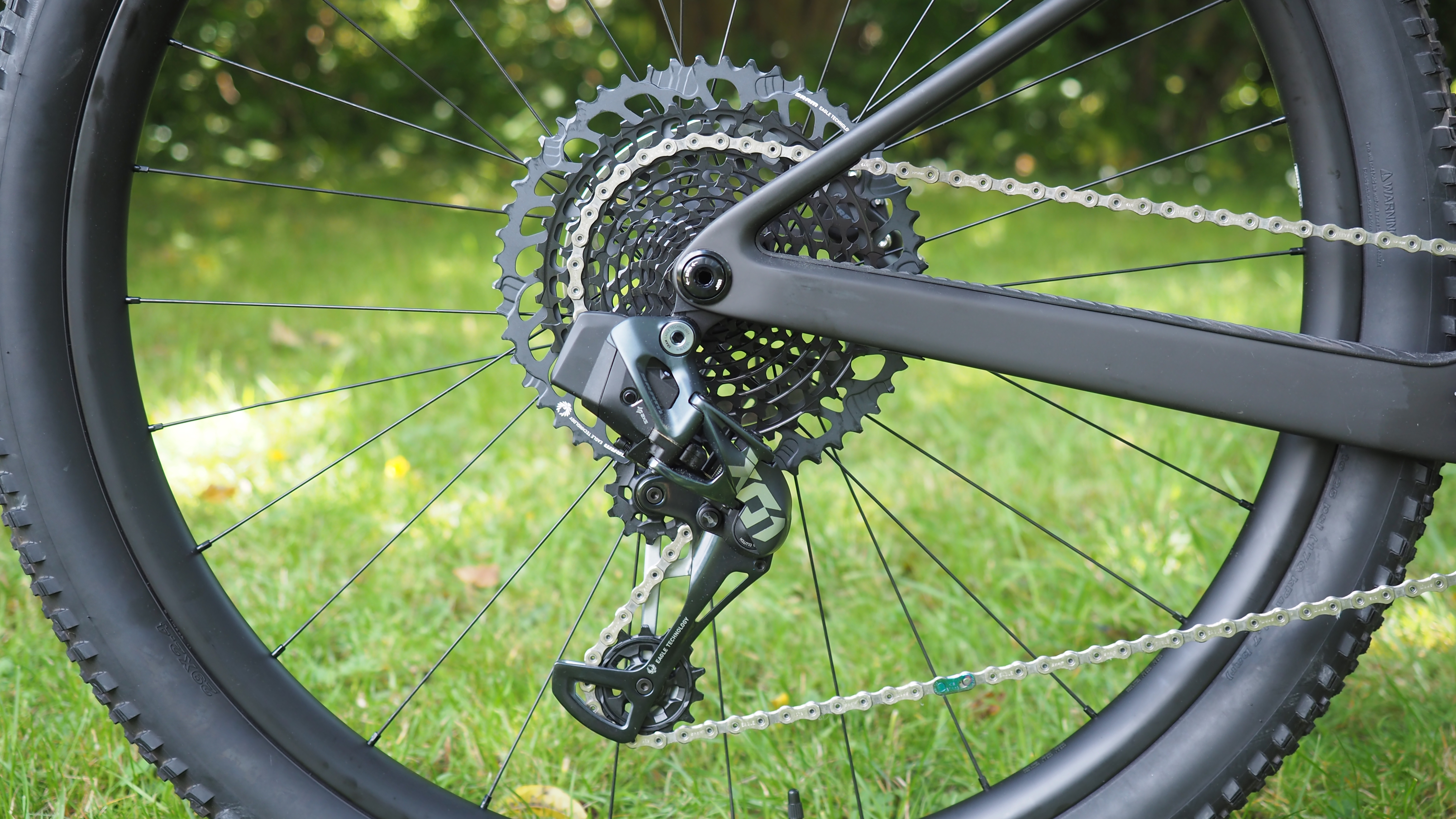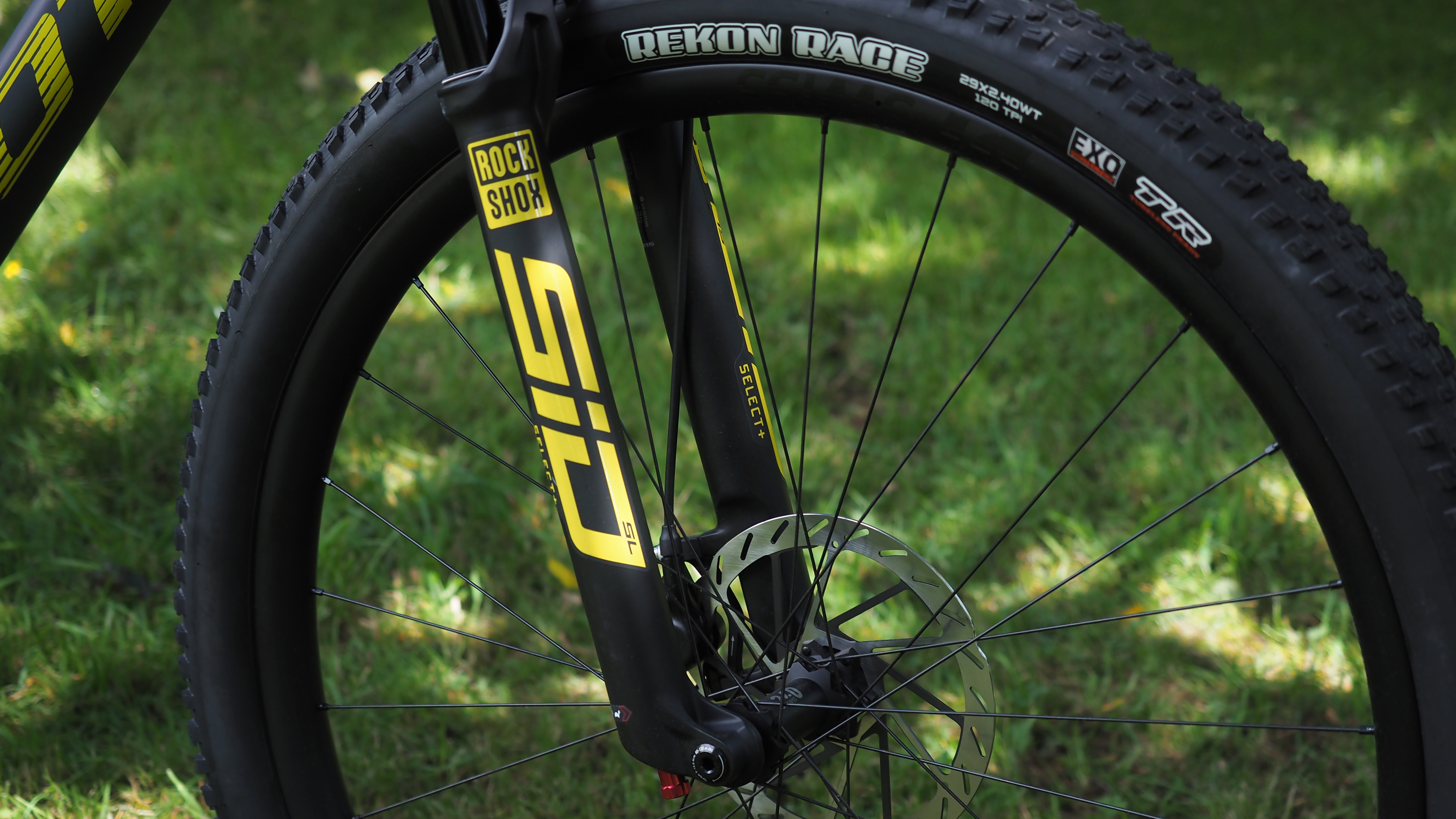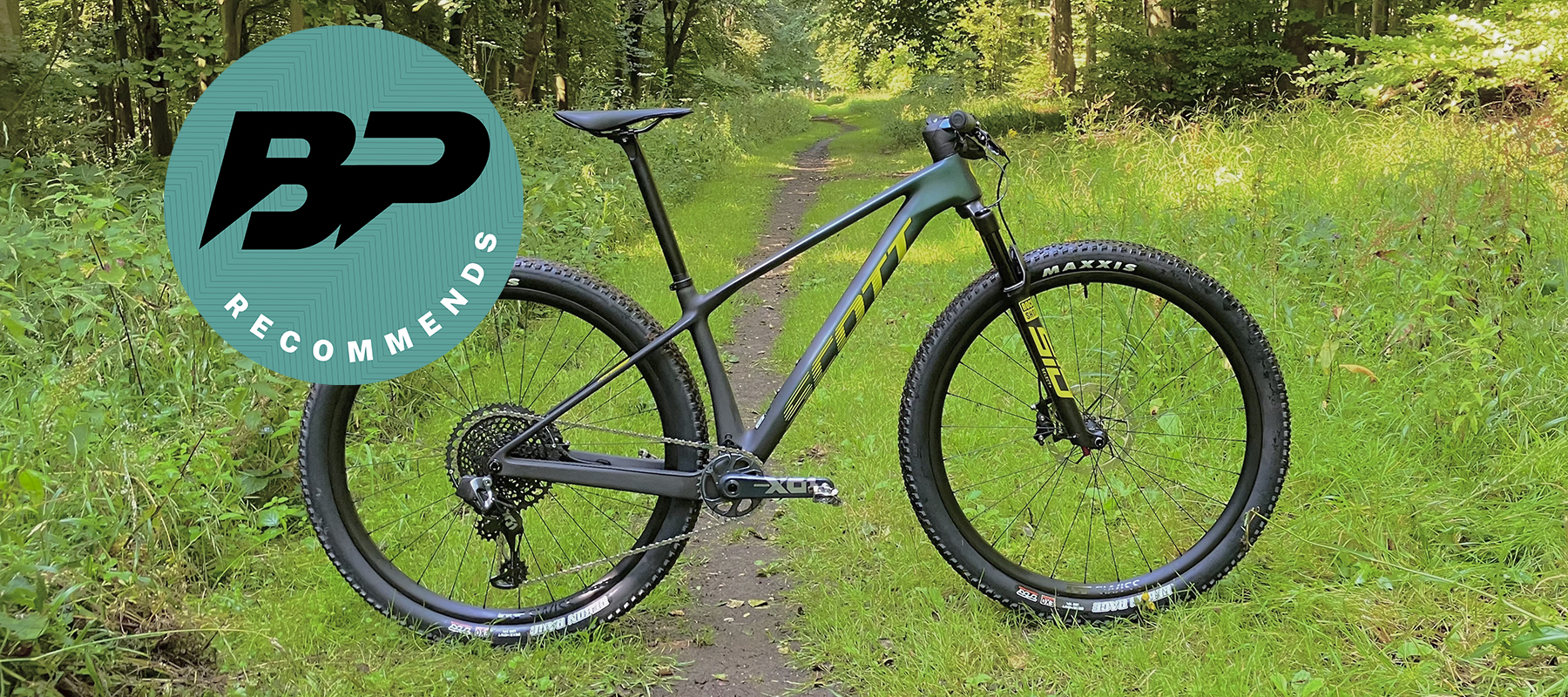Bike Perfect Verdict
In a world of increasingly light, capable XC full-sussers and tougher elite race courses, this high-end version of Scott’s legendary XC race hardtail might seem an out of touch indulgence – but it’s still eye-opening in the real world.
Pros
- +
Laugh out loud fast
- +
Smooth, assured front end
- +
Well-balanced back end
- +
Climbs like a demon
- +
Adjustable geometry
Cons
- -
100mm travel is conservative
- -
No UDH
- -
No dropper post
- -
Fast is its only speed
Why trust BikePerfect
When I was looking for a step up from my Specialized Chisel XC race hardtail, we planned a $3,000 / £3,000 group test to explore some different options from the best XC mountain bikes. Sadly (not sadly), Scott could only send the $7,500 / £6,500 RC World Cup instead, festooned with carbon everything, wireless SRAM X01 gears and RockShox SID SL Select+ forks, and weighing in at 9.7kg.
So this is a different test, and it’s fair to say my mind has been slightly blown by how it’s made me ride. It’s made me commit to corners in a new way, flow with the bike far more, and put in tiny bursts of extra power again and again where I’d have formerly freewheeled. More on this below.
At first I thought surely no one would have a premium hardtail any more as their primary MTB. I thought it’d be too niche, even for modern XC racing, where sub-10kg XC bikes come in both hardtail and full-suss forms. So it would not only be a bike purely for rich people, it’d only be a second bike for rich people, who would do most of their racing on a fast, light full-susser.
But time on it showed me that it still has some absurd advantages in a lot of XC race scenarios, and while it’s not exactly an all-round play bike, it’s a lot of fun in wild country, especially if your high-speed interests extend to the tougher end of gravel.
Design and geometry
As Guy explained in his look at the eye-wateringly range-topping Scott Scale RC SL, the 2023 Scale RC carbon frame has a combination of quiet and ingenious improvements that add up to what Scott describes as its biggest ever update between versions.
The weight has reduced a little, particularly in the entry-level HMF version of the frame, but most noticeable should be the compliance and the geometry. With lower seat stays, the rear triangle allows more natural shock absorption than before, and the carbon frame construction has become lighter and more sophisticated. And in terms of geometry, the Scale now sports a more stable front end and slightly longer reach for better maneuverability, balanced by a steeper seat tube to retain its climbing magic – all good and modern.

Kai Wheeler, the chief engineer with the enviable job of being in charge of this version of the Scale, says he had three main goals.
First, the racers wanted him to echo as much of the feel of Scott’s full-suss XC Spark as he could, but with a hardtail’s light weight and directness. So they’re particularly looking to balance stiffness and compliance, and give a surefootedness in descending.
Second was maintenance and usability, which means for example that while the internally routed cables are well protected and make the frame look sleek, they’re also accessible via a small door on the downtube. And third was futureproofing, which is for example why the Scale is compatible with a 110mm fork, as well as the 100mm it ships with this year.
There are four models in the Scale RC range (five in Europe), from the $3,500 / £2,800 RC Team to the $14,000 / £14,000 RC SL, and the good news if you’re on a budget is that they all share the same geometry and easily adjustable head angle, which can swap between 67.9 degrees and a relatively chilled 66.7 degrees. As well as a difference in components, there’s 100g of difference between the entry-level HMF frames and the mid-level HMX frames (on our World Cup bike and the World Cup Evo), but it’s not just about the weight: if you were super-attuned you might notice that the more nuanced construction gave a little more assurance at full chat over roots.
Components and build
The World Cup RC’s build is based around a fully wireless SRAM X01 Eagle 12-speed groupset with carbon crankarms. (This compares with XX1 on the $10,000 / £8,300 World Cup Evo, and GX on the European £4,150 Team Issue). Unlike the rest of the Scale RC range which uses Shimano brakes, the World Cup has SRAM Level TLM brakes, which some riders particularly rate for their modulation.

The seatpost is carbon and rigid – helping to keep the bike weight under the psychological 10kg threshold – though you can internally route a dropper. There’s more carbon for the one-piece handlebar and stem, which is a thing of beauty, but you’ll have to make do with titanium for the saddle rails.
Forks are RockShox’s buttery smooth SID SL Select+, with 32mm stanchions and 100mm of travel. They have a more sophisticated 3-mode damper than the regular SL Select on the Team Issue, and a twin lever RideLoc 2 remote.
It’s great to see 2.4in tires for an increased sense of confidence and control, even if (not surprisingly) the small-knobbed Maxxis Rekon Race prioritize light weight and fast rolling and work best in the dry. They sit on DT Swiss carbon XRC 1501 wheels, which have a generous 30mm internal width and tip the scales at just over 1,500g.

Ride, handling and performance
I enjoyed chucking the World Cup RC about on flowing southern trail centers, rockier ones in Snowdonia, local fast gravel and the chalky South Downs, where it promised to be an ideal long distance record hunter.
But my first impression before I’d even headed out was just how good looking it was. The pearlescent green paint, the tasteful highlights, the matching carbon bars, the way you can tell it’s a fast Scott from a hundred yards away. It sat there with a quiet confidence letting me know it was ready to rip as soon as I was.
Once I was off, the bike’s rate of acceleration literally made me laugh out loud. It’s almost more like a cyclocross bike than a mountain bike. That’s due in no small part to its feathery weight and its fast-turning carbon wheels and quick tires, but also the way power is channeled from the pedals to the wheels.

The other immediate impression was that as soon as the trails point upwards, the Scale World Cup RC climbs like a bullet, especially on firm ground and dry rock. That suited me no end. The riding position and lack of bulk made me feel like no effort was being wasted.
I was on the cusp of a small and medium for sizing, and picking the small, I appreciated how it was so easy to hustle about. The top tube is steeply angled, the front end is low, partly thanks to the -12-degree stem, and the bars, at 740mm wide, felt just the right width for balancing stability and flickability. The tires had an even, predictable profile across their whole width, which helped too.
All this made me shift the bike more decisively than usual, pushing into berms and holding rooty lines in a way that racing demands but I don’t often do. The combination of the forks, the tires, the geometry, the fit, the width of the handlebars made it feel easier to look ahead down the trail and just trust the bike will go there. It seemed much easier to make small adjustments to get to the right place on the trail and adjust an error even mid-turn, than on my higher-riding Chisel with 2.25in Vittoria Barzos on narrower rims.

I also felt that body movement made more of a difference to the handling of the bike than on the Chisel, with the hips and elbows translating into position on a line better.
The other difference was that it felt like the Scale wanted to attack the whole time. The lightness and speed of the electronic gear change, combined with the ease with which the bike seemed to respond to a stroke of extra power always made it worth blipping into the right gear and giving a few extra pedals between corners. Rewarding but exhausting.
While a short-travel super-responsive hardtail wouldn’t be your first choice for a Welsh trail center, I enjoyed more rough stuff than I thought I would while exploring where its limits lay, the forks picking their way through rock gardens better than I expected. As you might expect, the limits of a hardtail with race tires compared with a full susser or a bike with gnarlier tires were particularly obvious on loose, rocky climbs when you have to pick your lines with more thought, and deal more with skipping, sliding tires. Ditto on wet rock, or in claggier mud.
Descending was more capable than I’d anticipated, too, even without a dropper. I tried more loose and medium rock than I would have normally done and steered by skipping the back around.
Away from singletrack and XC race-day scenarios, you can see that the RC World Cup would be a promising companion for longer and rougher gravel riding or racing. Looking to smash my South Downs Way PB, I found it wasn’t as fast up hills as my 8kg cyclocross bike with 40mm tires, but unsurprisingly much faster on descents and less fatiguing on rougher flats, and on rockier courses it would have been even more of a no-brainer.

Things that I was surprised by: the brakes were fine but I thought they’d be more powerful given how much you could chuck yourself down. And – rookie error – I hadn’t realized the battery on the rear mech only lasted 25 hours, so I had to stay on top of that more than I’d planned when all-day epics were on the cards. I also expected to try the default steep headtube angle for a short while and then leave it in the slacker setting for lols, but I almost enjoyed the steep setting more for how it complemented the rest of the bike.
Verdict
The Scale RC World Cup is certainly an eye-opener. I wasn’t just hit by the laugh out loud speed but by the way the bike made me commit to lines more confidently and use my body to steer more. It was invigorating in a good way. It wasn’t relaxing, and sometimes the racey responsiveness made the brain write checks the legs eventually couldn't cash.
But it wasn’t the twitchy race-day-only steed I thought it’d be… it flattered your skills and fitness, you didn’t have to be on high alert just to keep it on a line, and while most people wouldn’t see it as an all-rounder, you could imagine it being the only bike of a XC and marathon racer whose other off-road kicks extended more to the fast gravel end of the scale.
And was it twice as good as my much cheaper hardtail? I’d like to try a cheaper Scale one day to see how the DNA filters down, but yeah, I’d say it was.
Test conditions
- Weather: British summer. Plenty of rain but not much mud
- Surface: Firm loam, Welsh rocks, gravel, rooty bermy bike parks
- Trails: Swinley, Friston, Coed y Brenin, Penmachno, South Downs, Cadair Idris, local woods and gravel
Tech specs: Scott Scale RC World Cup
- Discipline: XC and Marathon racing, fast rough gravel and bikepacking
- Price: $7,499 / £6,499 / €7,499
- Frame material: Scott HMX carbon composite
- Head angle: 67.9–66.7 degrees
- Wheel size: 29in
- Fork: RockShox SID SL Select+ RL3 100m travel fork with 3-mode damper and RideLoc2 remote control
- Chainset: SRAM X01 DUB Eagle Carbon crankarms, 32T chainring
- Rear mech: SRAM X01 Eagle AXS
- Shifter: SRAM GX Eagle AXS
- Cassette: SRAM X01, 10-52T, 12 speed
- Brakes: SRAM Level TLM with 180mm (front) and 160mm (rear) rotors
- Tires: Maxxis Reckon Race 29 x 2.4in
- Wheelset: DT Swiss XRC1501 carbon
- Bars and stem: Syncros Fraser iC SL XC carbon 740mm bar and integrated stem
- Seatpost: Syncros Duncan 1.0 carbon rigid seatpost
- Saddle: Syncros Belcarra 1.5, titanium rails
- Sizes: S (tested), M, L, XL

Sean has old school cycle touring in his blood, with a coast to coast USA ride and a number of month-long European tours in his very relaxed palmares. Also an enthusiastic midpack club cyclocross and XC racer, he loves his role as a junior cycle coach on the Kent/Sussex borders, and likes to squeeze in a one-day unsupported 100-miler on the South Downs Way at least once a year. Triathlon and adventure racing fit into his meandering cycling past, as does clattering around the Peak District on a rigid Stumpjumper back in the day.
Height: 173cm
Weight: 65kg
Rides: Specialized Chisel Comp; Canyon Inflite CF SLX; Canyon Aeroad; Roberts custom road bike

